[Link to News from January to April 2009] [Link to News from May to August 2009]
June 7th 2009
Manchester City Council is proposing to construct a safety fence along the side of Canal Street in Manchester. The fence would block access on foot for lock-wheelers to Lock 86 of the Rochdale Canal (details below).
Due to an error, the date of the decision on this plan has been put back and so there is still time to submit a comment up until June 19th (details below).
Also see BW's planned improvements to Lock 86.
Canal Street - background
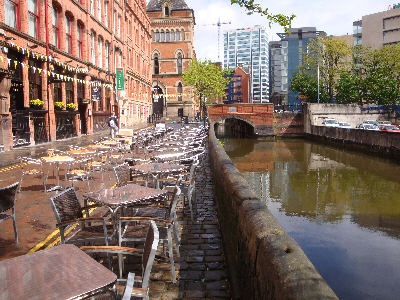
Canal Street alongside the Rochdale Canal.
The section of the Rochdale Canal through Manchester City Centre opened in 1800. This section is known as the "Rochdale Nine" because of the series of nine locks between Ducie Street junction and Castlefield.
Canal Street runs along the side of the canal for about 300 metres from Minshull Street to Princess Street. What is very unusual here, and which makes Canal Street special, is that the street itself forms the canal towpath along this 300 metre stretch, running at a height of between 2 and 3 metres above water level.
It seems likely that when the canal was built there was no wall along the edge of the street, but, at some point early in the canal's history, a stone slab wall was constructed along the edge of the street. The wall varies in height but is generally around 0.8 to 0.9 metres above street level. It was not built any higher than this in order not to snag the towing ropes of boats, which at that time were all horse drawn.
In recent years the area around Canal Street has developed as Manchester's "Gay Village" and Canal Street itself is lined with pubs and clubs, with groups of table and chairs along many parts of the street. The presence of the canal alongside the street is part of its attraction and gives it its special character.
Why a Fence?
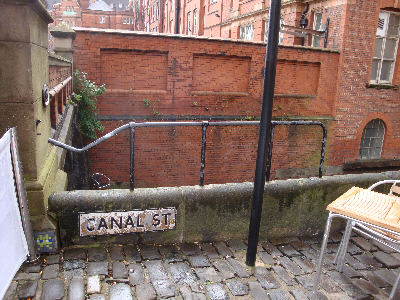
There is already a short iron railing along the lowest section of wall.
There have been several regrettable incidents in recent years that have resulted in people drowning. At an inquest in March 2008, the Coroner wrote: "I strongly urge for there to be a review of the waterways in the centre of Manchester with the intention of deciding what appropriate extra warning signage, lighting, life saving equipment, etc. may be appropriate in any given area. Consideration might need to be given to additional fencing or walling."
As a result, a proposal has been put forward by Manchester City Council to erect a fence along all three sections of Canal Street.
The fence, which will cost more than £200,000 to build, would consist of stainless steel posts set into the ground alongside the existing wall. The posts would curve over the the wall to hold a stainless steel rail, which would run directly above the wall. The gap between the wall and the rail would be filled by reinforced glass panels. The rail would be between 1.1 and 1.3 metres above street level.
What's the Problem?
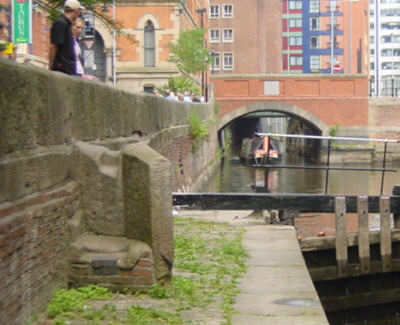
Access steps from Canal Street to Lock 86.
Although the need for safety is understood, many canal users are unhappy with the proposed fence, fearing it will be detrimental to the important and unique heritage value of Canal Street.
If the plan is approved, the fence will change the appearance of the historic canalside location. Unusually for a canal, the street itself forms part of the towpath. The wall between the street and canal is generally around 0.8 to 0.9 metres high, so as not to obstruct towing ropes, although it is lower in a couple of places.
The biggest problem for boaters that is likely to arise from the installation of this fence is that it will effectively prevent access on foot by crew members going ahead to set Lock 86.
For the last 200 years, boat crews have accessed the lock by climbing over the wall and using a stone block with steps carved into it. These strange steps are part of the heritage of the Rochdale Canal and making use of them is one of the experiences that makes this canal different.
When the plans were being drawn up, it would appear that British Waterways did not tell Manchester City Council that boaters access the lock via these steps. The "Design and Access Statement" states "There is no pedestrian access to the various landing stages along the Canal Street side of the canal."
The statement adds that an opening section of fence, unlocked with a special key, is to be provided for "canal maintenance operatives to climb over the wall to gain access to the central landing stage". The central landing stage is not where Lock 86 is but is the section of old towing path that runs under Sackville Street Bridge (see photos at bottom of page). However, the report prepared for the planning committee says that this opening gate will be above Lock 86, so there is some confusion as to where it will actually be. In any case, boaters would not be able to open it.
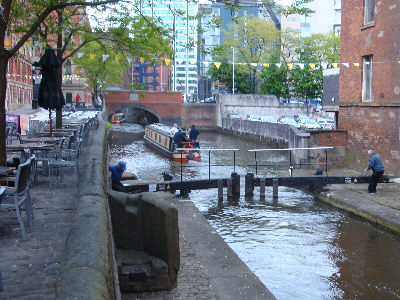
Two people are needed to close the gates after boats have passed through, as there is no walkway across the tail gates.
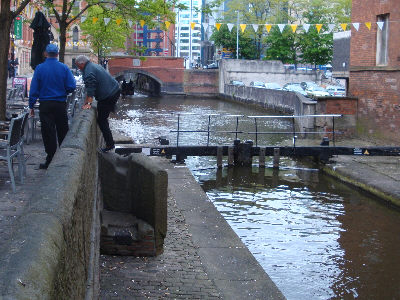
The BW operative and the boat crew member climb the steps without difficulty.
In the report for the planning committee, advice from British Waterways dismisses the concerns about access to Lock 86: "There is no need for canal boat users (including horse boaters) to climb up from the canal over the canal wall onto Canal Street or vice versa as the lock 86 can be operated from a boat within the canal itself."
It then contradicts that by saying: "Horse boating along a higher level towpath such as Canal Street requires one person to be in charge / control of the horse, one person to be in charge / control of the boat and ideally a third person to go ahead to set the next lock (or otherwise the person in charge of the boat)."
It is certainly possible for crew members to get on and off most boats at the lock entrance, but as there is only about 3 metres of landing above Locks 86 (and 87) it is not possible for crew members to get off the bow of a traditional working boat with a cargo hold. In addition, a horse-drawn boat cannot stop and start - it has to glide into an open lock, where it is stopped using ropes, either on a gate strapping post or on a lockside bollard.
There is a rickety wooden landing stage below Lock 86, but boaters have pointed out that the steep cobbled ramp from the landing to the lockside is treacherous in wet weather.
New landing stages above Locks 86 and 87 and an improved landing stage below Lock 86 would go a long way towards making lock operation safer, but there will still be occasions when it is necessary for boat crew members to access the lock on foot. For example, if the pound below the lock is a little low, it may be necessary for a crew member to let some water down from the pound above, so that the boat does not ground on the canal bed or damage the wooden lock cill.
Yet, the Conclusion of the report for the planning committee states: "As outlined above the fence will not hinder or interfere with the ability of canal users to navigate the canal."
Objectors contacting the planning department have been told that British Waterways has assured them that there will be no problems. The planners will naturally accept the word of BW over that of individual boaters. Yet a number of boaters are concerned that the people in BW who are advising the planners are not fully aware of the boating issues involved.
Not safe?
When British Waterways was challenged by Manchester IWA about pedestrian access to Lock 86, this startling response was received from a BW officer: "We do not feel that the continued use of the unofficial ledge to access this lock is a safe activity for any of our customers."
This so-called "unofficial ledge" is in fact the recognised means of pedestrian access to the lock and has been for 200 years. The impression has been given that the BW officer was not previously aware of these steps. Many boaters from all around the country will have used these steps to get on or off the lock landing. It is deeply upsetting to a number of local boaters that, because these steps are inconvenient for the fence plans, they are dismissed as being unsafe. The use of the derogatory words "unofficial ledge" seems designed to give the impression that these steps are of no importance.
Even if access to the steps is blocked by the fence, there will inevitably be times when a crew member will attempt to climb over - for instance, in order to let water down. Instead of climbing over a wall which is 0.8 metres high at that point, the boater would need to stretch awkwardly to get over a 1.3 metre high rail, with an equally high drop to the top of the step block. Thus an activity which most boaters would regard as safe will have been transformed into something that is definitely risky.
If the plans for the fence are approved, there should be a condition that access to Lock 86 by boat crew members on foot must be retained. Not to retain this access would be to solve a safety problem for one group by introducing other safety problems for another group. A safety expert advises that it is illegal to resolve safety issues by carrying out works that will create hazards for others.
A solution to this could be for new steps meeting modern safety requirements to be added a little further along the lock landing, accessed through an opening section of the fence. BW does not have money budgeted for this purpose but such steps should be included in the total cost of installing the fence, since access to the lock is an issue raised by the current fence proposal.
Horse-drawn Boats
The fence would make it more difficult for boats to be horse-drawn or hand-hauled along this section of the Rochdale Canal. The photo below shows that horse-drawn boats do occasionally use the canal and also demonstrates why the wall needed to be that height. It is already difficult to tow a boat by horse at Canal Street because of a number of obstructions. The additional height of the fence rail would obstruct the towing rope and make it more difficult to get sufficient pull in the short distances available.
It is also necessary for a crew member to go ahead and set the next lock (as acknowledged in the report to the planning committee). A horse-drawn boat cannot stop and start like a motor vessel - it has to glide into an open lock, where it is stopped using ropes, either on a gate strapping post or on a lockside bollard. The proposed fence would block foot access to Lock 86 for the lock-wheeler, as described above, making operation of a horse drawn boat considerably more difficult.
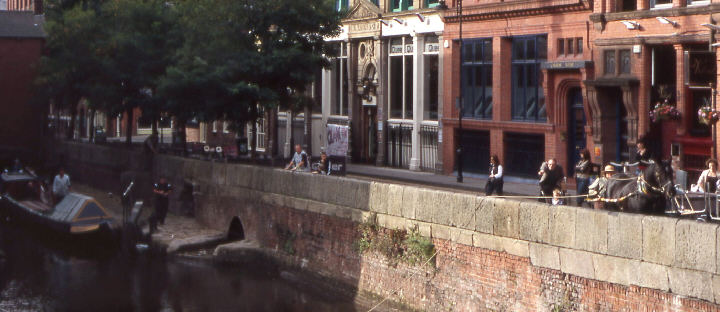
Boathorse preparing to tow a boat out of the lock on Canal Street, Manchester. Photo: Bob Jervis
What Can I Do?
The decision was originally to have been made on 28th May. However, as the correct notices were not displayed, new notices have been issued and a new period for comments allowed. Comments will now be accepted up until 19th June 2009.
The design of the proposed fence can be seen here. Other documents relating to the proposals can be viewed here.
Comments can be submitted online here on the council's planning website. The extended public consultation period ends on 19th June. If you have strong feelings about this application you can take this opportunity to make your views known.
The report that was to be presented to members of the planning committee can be seen here.

Lock 87 - access is from the other side via footbridge.
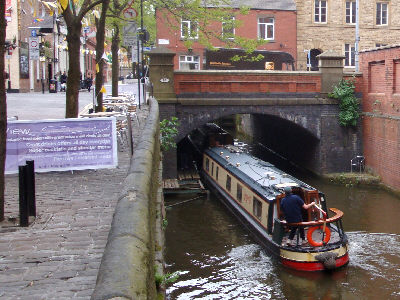
Wooden landing below Lock 86.
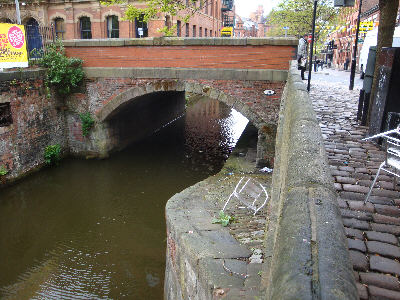
"Central landing" - former towpath under Sackville Street.
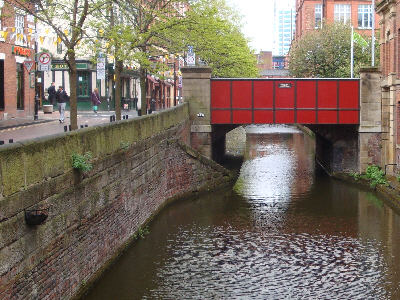
"Central landing" - former towpath under Sackville Street.
Read about BW's planned improvements to Lock 86.
See original item on this subject in April.